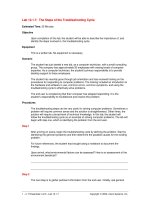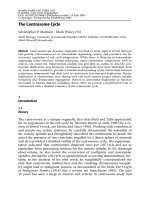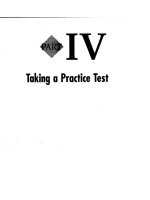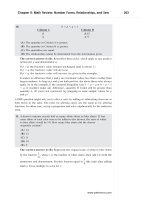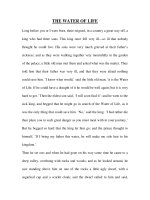the water cycle lessons 2-3
Bạn đang xem bản rút gọn của tài liệu. Xem và tải ngay bản đầy đủ của tài liệu tại đây (7.54 MB, 19 trang )
The Water The Water
CycleCycle
Lessons 2–3Lessons 2–3
CXECA08ARD503_LLR_CVb.indd 3CXECA08ARD503_LLR_CVb.indd 3 2/23/06 1:27:49 PM2/23/06 1:27:49 PM
Copyright © by Harcourt, Inc.
All rights reserved. No part of this publication may be reproduced or transmitted in
any form or by any means, electronic or mechanical, including photocopy, recording,
or any information storage and retrieval system, without permission in writing from the
publisher.
Requests for permission to make copies of any part of the work should be addressed to
School Permissions and Copyrights, Harcourt, Inc., 6277 Sea Harbor Drive, Orlando,
Florida 32887-6777. Fax: 407-345-2418.
HARCOURT and the Harcourt Logo are trademarks of Harcourt, Inc., registered in the
United States of America and/or other jurisdictions.
Printed in the United States of America
ISBN-13: 978-0-15-349193-1
ISBN-10: 0-15-349193-0
1 2 3 4 5 6 7 8 9 10 179 15 14 13 12 11 10 09 08 07 06
If you have received these materials as examination copies free of charge, Harcourt
School Publishers retains title to the materials and they may not be resold. Resale of
examination copies is strictly prohibited and is illegal.
Possession of this publication in print format does not entitle users to convert this
publication, or any portion of it, into electronic format.
CXECA08ARD503_LLR_CVb.indd 4CXECA08ARD503_LLR_CVb.indd 4 2/23/06 1:28:26 PM2/23/06 1:28:26 PM
Visit The Learning Site!
www.harcourtschool.com
Orlando
Austin
New York
San Diego
To r onto
London
Lesson 2
How Do Californians Get the Water
They Need? . . . . . . . . . . . . . . . . . . . . . . . . . . . . . . . . . . . . 2
Lesson 3
How Can People Conserve Water?. . . . . . . . . . . . . . . . . 10
The Water
Cycle
Lessons 2–3
CXECA08ARD5032-3_BLR06_01 1CXECA08ARD5032-3_BLR06_01 1 2/24/06 3:17:06 PM2/24/06 3:17:06 PM
VOCABULARY
watershed
dam
reservoir
aqueduct
groundwater
The mountain waters flow
down through the creeks and
rivers of the watershed.
How Do How Do
Californians Californians
Get the Water Get the Water
They Need?They Need?
2
A dam helps control a river.
2
2
CXECA08ARD5032-3_BLR_01 2CXECA08ARD5032-3_BLR_01 2 2/23/06 3:04:04 PM2/23/06 3:04:04 PM
Los Angeles has two large
aqueducts. They carry water to
the city.
The water we use in our
homes was stored in a
reservoir.
3
When someone pumps the handle on the
well, groundwater comes out.
CXECA08ARD5032-3_BLR.indd 3CXECA08ARD5032-3_BLR.indd 3 10/6/06 3:13:14 PM10/6/06 3:13:14 PM
4
READING FOCUS SKILL
MAIN IDEA AND DETAILS
The main idea is what the text is mostly about.
Details tell more about the main idea.
The main idea is California’s water. Look for details
about where the water you need to live comes from.
Learn how you can conserve it.
Water Resources
The human body is 60 to 75 percent water. That means you
have about 40 liters, or 10 gallons, of water flowing around
inside you!
Water is a useful resource. People need water for many
different reasons. Fresh water is very important to human
health. You need to drink plenty of water to stay healthy.
Fresh water is needed for growing plants for our food. We
also use fresh water for bathing, washing clothes, and cooking.
Most crops need
fresh water to grow.
CXECA08ARD5032-3_BLR_04 4CXECA08ARD5032-3_BLR_04 4 2/25/06 9:49:09 AM2/25/06 9:49:09 AM
5
Fresh water is important, but salt water is useful, too.
Oceans provide many resources.
People who live in places that have very little fresh water
may use ocean water. They must first remove the salt and
other minerals from the water.
Saltwater animals, such as fish and shrimp, are important to
many people’s diets. Sea salt is another resource. It is used for
cooking and preserving foods.
Oceans are also used for recreation. You can surf, sail, and
scuba dive in salt water.
How is fresh water useful?
CXECA08ARD5032-3_BLR_01 5CXECA08ARD5032-3_BLR_01 5 2/23/06 3:04:42 PM2/23/06 3:04:42 PM
Local Water Sources
Where do people get fresh water? Many communities in
California get water from lakes and rivers. Rain and snow keep
lakes and rivers full.
6
main river
flood plain
wetland
headwaters
tributary
CXECA08ARD5032-3_BLR06 6CXECA08ARD5032-3_BLR06 6 2/24/06 3:16:20 PM2/24/06 3:16:20 PM
7
When rain or snow falls, it collects in a
watershed
. A
watershed is an area of land with creeks and rivers.
When rain falls or snow melts on a mountain, the water runs
into small creeks. The creeks join to form rivers. The creeks and
rivers work together to drain the water from an area of land.
The area that is drained is called a watershed.
Many communities build dams to store water for future use.
A
dam
is a barrier that crosses a river and controls the flow of
water. Water collects behind a dam to form a
reservoir
.
California’s largest reservoir is Shasta Lake. Its water is
cleaned and pumped to homes, businesses, and farms.
If communities need more water, they may bring it from a
faraway watershed. They may use an
aqueduct
to transport
the water. An aqueduct is a large pipe or channel. Los Angeles
uses two aqueducts to bring water from the Owens River
valley watershed.
How does Los Angeles get water from the
Owens River valley watershed?
CXECA08ARD5032-3_BLR_04 7CXECA08ARD5032-3_BLR_04 7 2/25/06 9:49:19 AM2/25/06 9:49:19 AM
8
Groundwater
Not all of California’s water comes from rivers and lakes.
About 40 percent of California’s population uses groundwater.
Groundwater
is water under Earth’s surface. It is in the spaces
between rocks and soil.
When water soaks into the ground, most of it slowly flows
down to an area called the water table. You can think of the
water table as a line under the ground.
The area above the water table has pockets of air. The
ground below the water table is completely filled with water.
It is called an aquifer. It stores groundwater.
Water can be pumped up from an aquifer through a well. A
well is a hole that is drilled through the ground to the aquifer.
A well can supply water for one home, one neighborhood, or
a whole city.
Where does groundwater collect?
water table
runoff
CXECA08ARD5032-3_BLR_01 8CXECA08ARD5032-3_BLR_01 8 2/23/06 3:06:25 PM2/23/06 3:06:25 PM
9
Complete this main idea statement.
1. Most communities in California get ______ from
lakes and rivers.
Complete these detail statements.
2. A community may be able to take fresh water
from rivers that drain a ______.
3. An ______ can transport water from another
watershed.
4. The ground below the water table is called
the ______ .
Review
Review
groundwater
well
CXECA08ARD5032-3_BLR_09.indd 9CXECA08ARD5032-3_BLR_09.indd 9 2/23/06 3:15:29 PM2/23/06 3:15:29 PM
VOCABULARY
pollution
water quality
conservation
reclamation
How Can How Can
People People
Conserve Conserve
Water?Water?
10
Factories sometimes release pollution into the
water, ground, and air.
3
3
CXECA08ARD5032-3_BLR_09.indd 10CXECA08ARD5032-3_BLR_09.indd 10 2/23/06 3:15:48 PM2/23/06 3:15:48 PM
Reclamation is a good way to
conserve water. Farmers use
reclaimed water on their crops.
The water quality of polluted
water is very poor. The water is
not safe to drink.
When we recycle water and use less water,
we practice conservation.
11
CXECA08ARD5032-3_BLR_09.indd 11CXECA08ARD5032-3_BLR_09.indd 11 2/23/06 3:15:52 PM2/23/06 3:15:52 PM
12
READING FOCUS SKILL
CAUSE AND EFFECT
A cause is something that makes another thing
happen. An effect is the thing that happens.
As you read, you will find examples of how people
affect their water resources.
Water Pollution
People need clean water to stay
healthy, But some of Earth’s water is
polluted.
Pollution
is any change to
a resource that makes the resource
unhealthful to use.
Water can become polluted
when harmful wastes enter the
water cycle. Some harmful wastes
come from factories or mines.
These can be dumped into rivers
and lakes. Wastes can also get into
groundwater. People who have
yards or farms often use chemicals
that can pollute groundwater.
Another souce of water pollution
is sewage. Sewage is human waste.
If sewage gets into the water that
people use, they can get sick.
Wastes can
spill or leak.
The wastes
seep into
underground
water.
CXECA08ARD5032-3_BLR_12 12CXECA08ARD5032-3_BLR_12 12 2/23/06 5:26:27 PM2/23/06 5:26:27 PM
13
Scientists measure how safe water is for humans, animals,
and plants. This measurement is called
water quality
. Water
is safe to use if it has good water quality. Pollution harms
water quality. Polluted water is dangerous to use.
Laws are written to help keep good water quality. Factories
and cities must clean water after they use it. Also, they can’t
dump chemicals in rivers.
What do harmful wastes do to water quality?
If the polluted water joins
larger bodies of water, it
pollutes them, too.
The polluted water
reaches the ocean
and pollutes it.
Groundwater Pollution
CXECA08ARD5032-3_BLR_12 13CXECA08ARD5032-3_BLR_12 13 2/23/06 5:26:44 PM2/23/06 5:26:44 PM
14
Water Conservation
There is limited fresh water in reservoirs and in the ground.
Water is a resource that must be conserved, or protected.
Water
conservation
is important in California because of
droughts. A drought is a long period without rain. Also, the
population of California is growing. More people need to
share water resources.
We can reduce the amount of water we use. Water can
also be recycled. Polluted water can be cleaned at a water
treatment plant.
Steps in Waste-Water Treatment
sources
waste-water
collection
sedimentation
primary
treatment
oxygen
reactors
settling/
clarifying
beneficial
reuse
CXECA08ARD5032-3_BLR_09.indd 14CXECA08ARD5032-3_BLR_09.indd 14 2/23/06 3:16:41 PM2/23/06 3:16:41 PM
15
Complete these cause and effect statements.
1. Water becomes ______ when harmful substances
enter the water cycle.
2. Because we have limited amounts, fresh water must
be ______ , or protected.
3. To conserve water, ______ water can be used to
water plants, flush toilets, and wash cars.
4. Polluted water can lower the water ______ of
groundwater.
Review
Review
Another way to conserve water is not to have a lawn. Lawns
need great amounts of water. To save water, homeowners can
grow plants that use less water.
Some communities practice water
reclamation
. Reclaimed
water is not cleaned as well as drinking water. Reclaimed water
can be used for fighting fires, flushing toilets, and watering
certain plants. Reclaimed water is not for drinking.
Farmers can conserve water by dripping it onto the ground
through small tubes instead of using sprinklers. This uses much
less water.
You can conserve water, too. Take shorter showers. Do not
run the water while you brush your teeth. Try to think of other
ways to conserve our water.
Why does California need to conserve water?
CXECA08ARD5032-3_BLR_09.indd 15CXECA08ARD5032-3_BLR_09.indd 15 2/23/06 3:16:47 PM2/23/06 3:16:47 PM
16
Glossary
aqueduct [AK•wuh•duhkt] A pipe or channel that is used to
transport water.
conservation [kahn•ser•VAY•shuhn] The preserving and
protecting of a resource.
dam [DAM] A barrier across a river, controlling its flow.
groundwater [GROWND•wawt•er] Water that is located in soil
and rocks below Earth’s surface.
pollution [puh•LOOSH•uhn] Any change to a resource that
makes the resource unhealthful to use.
reclamation [rek•luh•MAY•shuhn] The recycling of water that
has already been used by people.
reservoir [REZ•er•vwahr] A body of water stored for
future use.
water quality [WAWT•er KWAWL•uh•tee] The measure of how
safe water is for human use.
watershed [WAWT•er•shed] An area of land that is drained by
a series of creeks and rivers.
CXECA08ARD5032-3_BLR_16 16CXECA08ARD5032-3_BLR_16 16 2/25/06 11:46:15 AM2/25/06 11:46:15 AM
School-Home Connection
With a family member, write a water conservation plan. Find three
ways to conserve water in your home. Place in your home to remind
your family to use less water.
Hands-On Activity
Collect samples of sand, dirt, and small pebbles. Add this “pollution” to a
sample of clean water in a cup. Place a coffee filter inside a funnel. Slowly
pour the water into the coffee filter.
1. Does the filter hold back the pollution?
2. Does the water look pure, or do you need to filter it again?
Think About the Reading
1. How does the diagram on page 13 explain the effects of
pollution?
2. What section would you read again to understand more about
aquifers?
CXECA08ARD503_LLR_CVb_05 5CXECA08ARD503_LLR_CVb_05 5 2/24/06 2:11:56 PM2/24/06 2:11:56 PM
